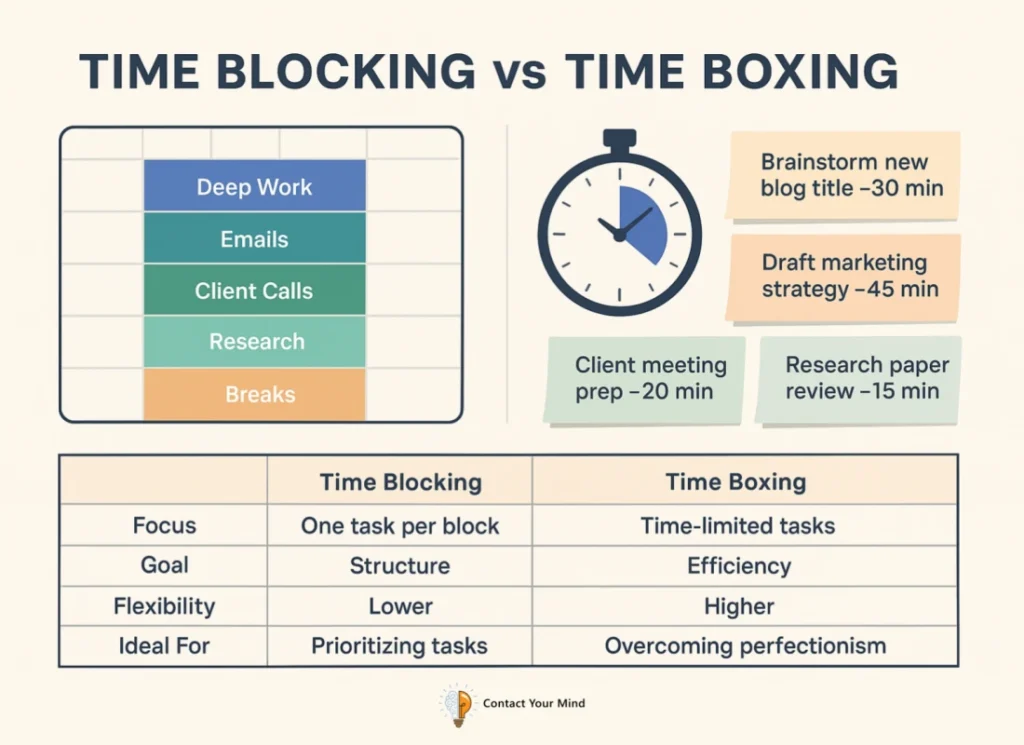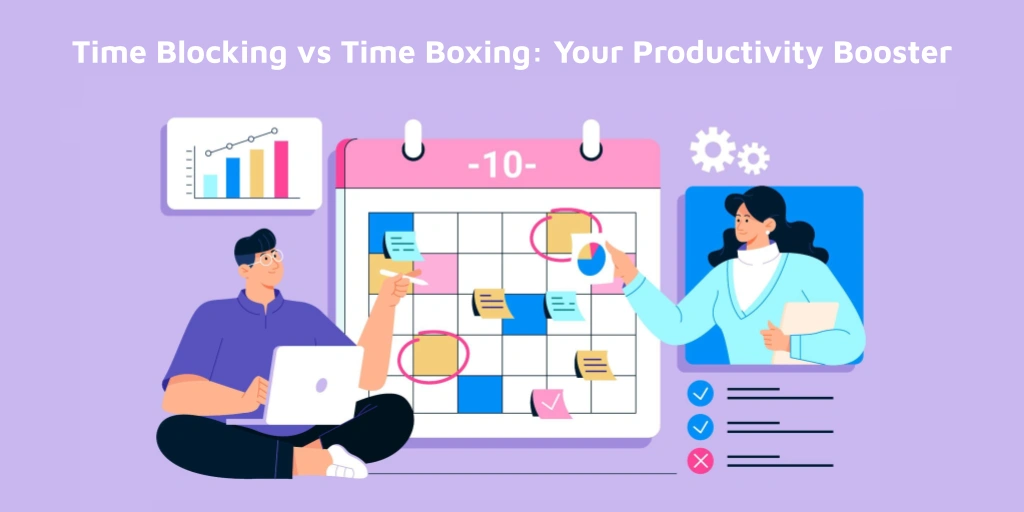Last Updated: July 7, 2025
Today’s world has become so fast-paced that managing time has become more challenging than ever. Also, don’t forget your biggest enemy here – Distractions.
Back to back meetings, endless notifications, growing to-do lists, a pile of huge tasks gets stacked up making you feel overwhelmed and worthless.Don’t worry my friend, you’re not alone here.
That’s where I will explain to you about the two highly effective time management techniques called Time Blocking and Time Boxing.
These methods are not just some fancy words, they are actually backed up by productivity experts, research, and real-world applications. In this guide, we will dive deep into the definitions of Time Blocking and Time Boxing, their benefits, differences, and how to implement them into your schedule to bring yourself back on track.
What is Time Blocking?
Time Blocking is a scheduling method where you divide your day into blocks of time, with each block dedicated to a specific task or group of similar tasks.
Instead of reacting to your day as a whole, you plan every hour in advance. This method helps you focus on one activity at a time. This technique ensures your focus and helps to reduce the fatigue and anxiety of multiple tasks in your schedule.
Thus it reduces the chances of multitasking and improves overall efficiency.
Benefits of Time Blocking
- Enhanced Focus: Working in time blocks by allocating specific time slots to individual tasks, helps you to concentrate fully on the current task. Thus minimizing distractions.
- Clarity & Better Task Prioritization: Time Blocking allows you to prioritize your tasks, and makes you do important activities first with your utmost attention. You clearly see what needs to be done and when. Thus making decision-making easier.
- Improved Productivity: With a clear schedule, you can manage your time more efficiently, leading to increased productivity. According to a 2022 study published in Nature Human Behaviour, planning your day can boost task performance by 20%.
- Reduced Stress: With a visual schedule, you spend less time worrying about forgetting tasks. Knowing exactly what to work on and when to work on next reduces stress and anxiety.
Time Blocking Template and Example
To get started with the Time Blocking method, you can use a simple template that shows your daily schedule. Here’s an example of a Time Blocking template:
| Time Slot | Task |
| 6:00 AM – 7:00 AM | Morning routine (exercise, meditation) |
| 7:00 AM – 9:00 AM | Deep work (focused project) |
| 9:00 AM – 10:00 AM | Emails & communication |
| 10:00 AM – 12:00 PM | Meetings or calls |
| 12:00 PM – 1:00 PM | Lunch and walk break |
| 1:00 PM – 3:00 PM | Task execution or creative work |
| 3:00 PM – 4:00 PM | Administrative tasks |
| 4:00 PM – 5:00 PM | Review and plan next day |
| 5:00 PM – 6:00 PM | Personal time |
You are free to customize this template as per your specific needs and preferences.
If you struggle to get started with any task, refer to this – “Why Do I Have Hard Time Starting Tasks?”
What is Time Boxing?
Time Boxing is a technique where you allocate a fixed amount of time period to work on a task, regardless of whether the task is completed within that particular time frame. This method makes you work within set boundaries. Thus helping you promote efficiency and preventing perfectionism from consuming too much time.
This method helps you to tackle the issue of Analysis Paralysis.
Benefits of Time Boxing
- Boosts Efficiency: By limiting the time spent on a task, you work on tasks without worrying much and avoid unnecessary procrastination. Tasks that would otherwise stretch for longer hours, actually get completed faster.
- Overcomes Perfectionism Issue: It forces you to prioritize progress over perfection.
- Better Energy Management: This method avoids exhaustion by maintaining clear time limits for your tasks.
- More Intentional Breaks: As there is built-in rest times between tasks, it can prevent fatigue. Also, by setting clear time boundaries, you can prevent work from spilling over into your personal time.
Time Boxing Template and Example
Let’s consider an example of time boxing for a typical workday:
| Task | Time Boxed Duration |
| Writing a blog draft | 9:00 AM – 10:00 AM |
| Team check-ins | 10:00 AM – 10:30 AM |
| Content review | 10:30 AM – 11:00 AM |
| Product planning | 11:00 AM – 12:00 PM |
In this example, each task is given a specific time box. This is to ensure that all activities receive the required attention without overextending their allocated time.
Time Blocking vs Time Boxing: Key Differences
| Criteria | Time Blocking | Time Boxing |
| Focus | One task per time slot | Task limited by time |
| Goal | Structured flow | Speed & efficiency |
| Flexibility | Fixed schedule | More fluid within boundaries |
| Ideal For | Creatives, planners, deep work | Perfectionists, agile workers, ADHD management |

Expert Insight About Time Blocking & Boxing
A Harvard Business Review study found that professionals who scheduled tasks in advance (blocking) and set time limits (boxing) reported 25% better task completion and 30% less work-related stress.
How to Implement Both Time Blocking & Boxing Techniques?
Implementing these techniques requires some planning and discipline. Here are steps to help you get started with both methods:
Step-by-Step Guide for Time Blocking Method:
- List Your Tasks: List all the tasks you need to complete, including work-related activities, personal commitments, and breaks.
- Prioritize: Determine the importance and urgency of each task to allocate appropriate time blocks. You can take help of the 4 Quadrants of Urgent Important Matrix to prioritize your tasks effectively.
- Create Time Blocks: Use a Time Blocking template to allocate specific time slots for each task, such as allocate 1-2 hour blocks for focus work, along with breaks.
- Stick to It: Follow your time-blocked schedule and avoid shifting tasks unless necessary. Making adjustments only during emergencies.
- Evaluate Weekly: Check what worked and refine your schedule to identify areas for improvement and make appropriate adjustments.
Step-by-Step Guide for Time Boxing Method:
- Set a Timer: Allocate specific time boxes for each task, to ensure that you have a balanced distribution of time throughout your day. Techniques such as Pomodoro-style (25/5) or full-hour blocks can be helpful.
- Define Deliverables: What must be done in this box? Make a list of all tasks you need to complete, categorizing them based on their importance and complexity.
- Work Within Time Limits: Even if not finished, move on to the next task. This will avoid perfectionism and unnecessary delays.
- Track Progress: Use a journal or tool like Toggl.
- Adjust Timeboxes: Review your work to identify those tasks that need shorter or longer spans. Thus adjust your time boxes accordingly.
Combining Time Blocking and Time Boxing
You don’t have to choose one.
In fact, combining both the Time Blocking and Time Boxing can maximize the overall productivity:
For instance, you can use time blocking to create a structured daily schedule and incorporate time boxing within those blocks to manage specific tasks efficiently.
Example of Combined Approach:
Use Time Blocking to lay out your day. Then, use Time Boxing within those blocks to work with a goal in mind.
- Time Block: 2:00 PM – 4:00 PM — Work on client or business proposal
- Time Boxes within the Block:
- 2:00 PM – 2:45 PM — Research client or business background
- 2:45 PM – 3:30 PM — Draft it’s outline
- 3:30 PM – 4:00 PM — Proofread and make adjustments
- 2:00 PM – 2:45 PM — Research client or business background
In this example, Time Blocking provides a structured schedule, while Time Boxing ensures that tasks are completed efficiently within their allocated time slots.
Tools to Help You Get Started
- Google Calendar (for blocking)
- Toggl Track / Clockify (for time boxing)
- Notion, Sunsama, Akiflow, Motion (hybrid planners)
- Focus Keeper / Forest App (for Pomodoro boxing)
Statistics and Insights Supporting Time Blocking & Boxing
Research data supports both the Time Blocking and Time Boxing in improving productivity and time management. According to a study by the American Psychological Association, structured time management techniques can increase productivity by up to 25%. Additionally, as mentioned earlier, a survey conducted by the Harvard Business Review found that employees who use time management techniques, such as time blocking and time boxing, report higher levels of job satisfaction and reduced stress.
Furthermore, a study published in the Journal of Applied Psychology found that setting specific time limits for tasks (time boxing) can improve focus and task completion rates by 30%. These statistics highlight the benefits of merging these techniques into your daily routine.
Conclusion: Which Method is Right for You?
If you seek structured work and like to plan your day ahead, Time Blocking will help you create mental clarity and space for deep work. If you often overthink, fall behind, or strive for “perfect work,” Time Boxing will add the limitation you need or will act as a force for you to work and deliver results faster and more productively.
Quick Recap:
- Use Time Blocking to organize your day
- Use Time Boxing to control your time on each task
- Combine both for powerful results
“You can’t manage what you don’t measure. And you can’t improve what you don’t control.”
FAQs (Frequently Asked Questions)
Q: Can Time Blocking work for unpredictable schedules?
A: Yes. You can use flexible time blocks or plan buffer periods for last-minute tasks.
Q: Is Time Boxing effective for creative work?
A: Yes, it can help limit overthinking and improve output. Just avoid boxing brainstorming sessions too tightly.
Q: How long should a time box be?
A: 25-60 minutes is common. Experiment and adjust based on focus span.



